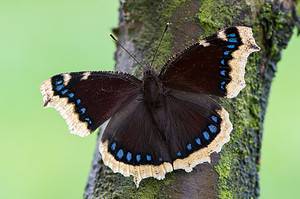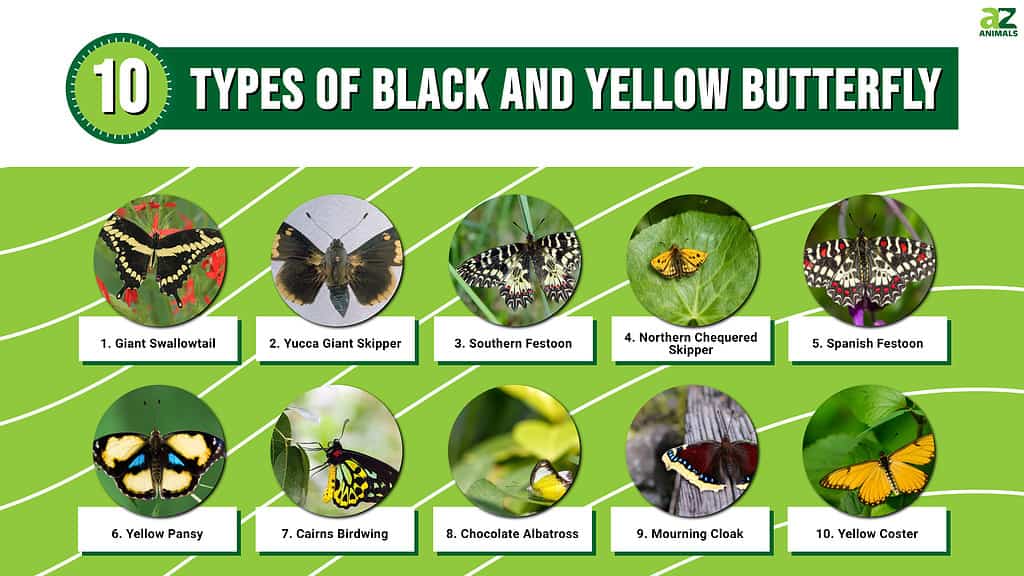
Butterflies have been on our earth for millions of years after evolving from an ancient moth-like insect. They are one of the few insects that people enjoy finding and looking at. In fact, their bright colors and unique patterns brighten gardens and backyards, bringing symbols of hope and new beginnings. Do you have a specific butterfly you need to identify? Check out these 10 types of black and yellow butterflies!
1. Giant Swallowtail
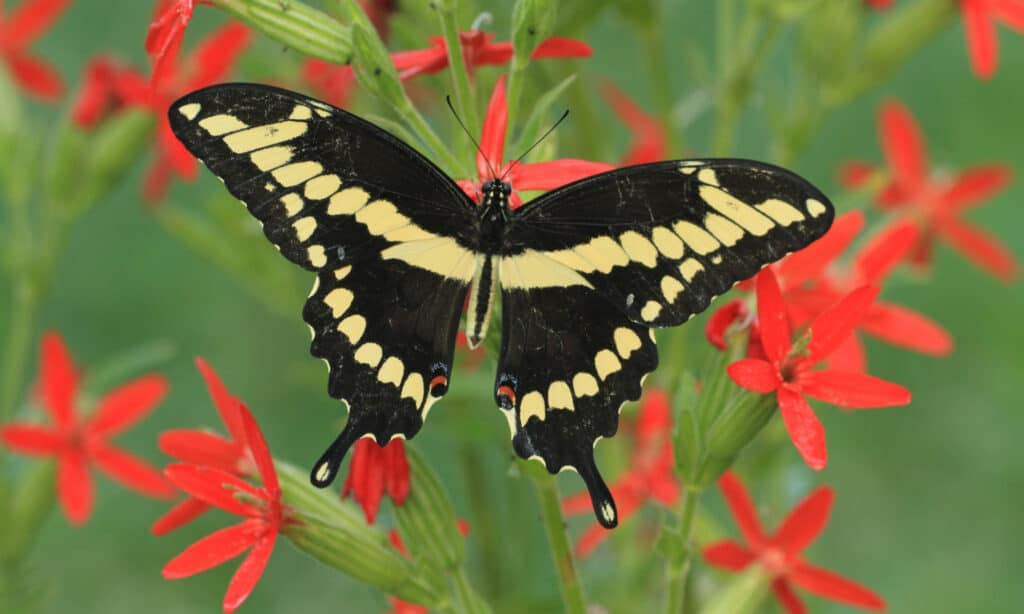
Giant swallowtails are pests on citrus farms. Their larval stage causes significant damage to young plants.
©Kevin Collison/Shutterstock.com
Giant swallowtails (Papilio cresphontes) are black and yellow butterflies that have a striking appearance that many find appealing. They are the largest butterflies in North America and are common within their range. However, this species is regarded as a pest to citrus farms. For instance, their larval stage causes significant damage to young plants, earning them the nickname “orange pups.”
Location/Habitat: They have an abundant population in the Eastern United States and some parts of Canada, Mexico, Jamaica, and Cuba. Also, they inhabit deciduous forests and citrus orchards.
Description: Giant swallowtails have black wings with horizontal yellow lines across the forewings and diagonal lines across the hindwings. They are most notable for their size because they reach up to 7 inches long.
2. Yucca Giant Skipper

The yucca giant skipper is a robust butterfly native to the Southern United States and Northern Mexico.
© CC BY 3.0 US – License
Yucca giant skippers (Megathymus yuccae) are early-season butterflies known for their large and robust bodies. You will find them in many habitats, although spotting one can be rare. Adults don’t typically congregate in groups, and males are very swift fliers.
Location/Habitat: They are permanent residents in the Southern United States and Northern Mexico. This species inhabits many environments, including deserts, foothills, and woodlands. They are specifically attracted to yucca plants (hence the name).
Description: Their wings are brown with yellow spots. Additionally, their undersides are mottled black and gray.
3. Southern Festoon
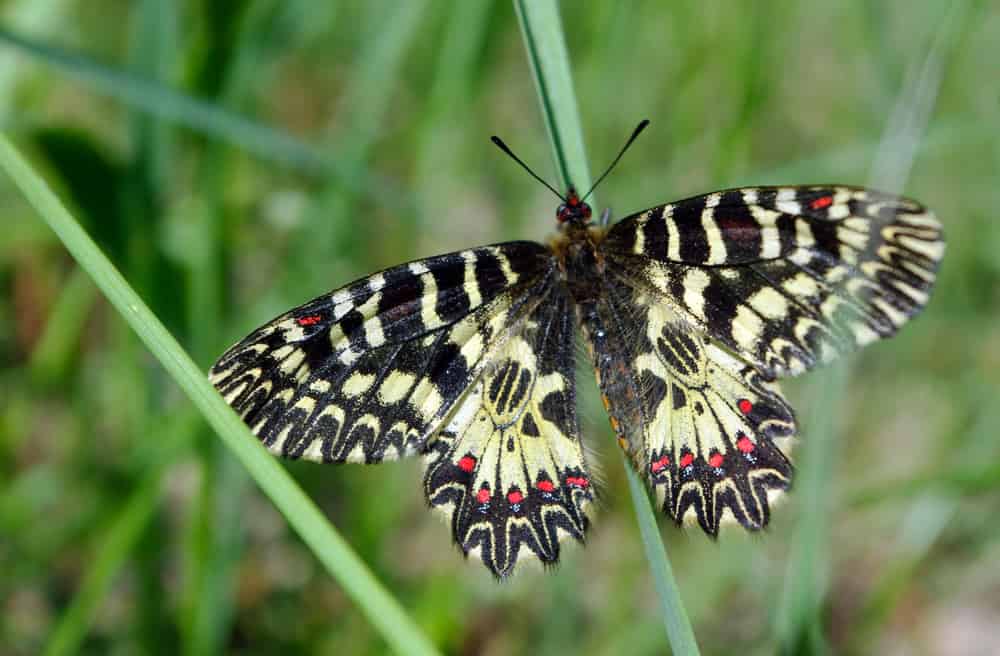
Southern festoons are native to Central and Southern Europe and relatively rare within their range.
©KRIACHKO OLEKSII/Shutterstock.com
The southern festoon (Zerynthia polyxena) often gets confused with the Spanish festoon because the two can look similar. The southern features a complicated pattern on its wings. Although widespread, this species is rare within its range and only seen locally. The southern festoon has many subspecies that slightly differ based on location.
Location/Habitat: They are native to Central and Southern Europe, stretching from the Balkans to Kazakhstan. They prefer warm, open areas in grassy meadows, river banks, rocky cliffs, vineyards, and cultivated land.
Description: Southern festoons are light yellow with intricate black and brown patterning and red spots. Females tend to be slightly longer with lighter coloring. You can tell them apart from the Spanish festoon by the presence of blue on its hindwings.
4. Northern Chequered Skipper

Northern chequered skippers are robust and muscular. They range from Northern Europe to Northeastern Asia.
©adamikarl/Shutterstock.com
The northern chequered skipper (Carterocephalus silvicola) belongs to the skipper family, comprising 4,000 species, with only 40 native to Europe. Skippers are typically more robust than regular butterflies and feature larger heads and more muscular bodies and wings. They are fairly common within their range, and you can see them flying in May and June.
Location/Habitat: They range from Northern Europe to Northeastern Asia. And they are commonly found in the central and southern regions of Finland. You can spot them in damp flowered meadows and lush forests.
Description: Northern chequered skippers are yellow with blackish-brown spots and patterns.
5. Spanish Festoon
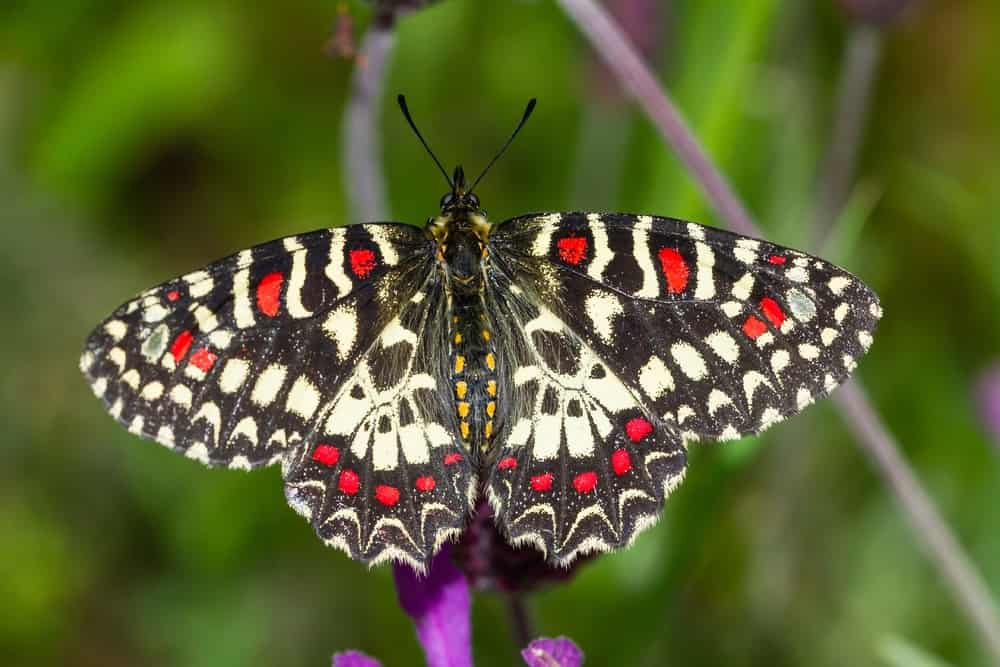
Spanish festoons have clearly defined red spots on their forewings, unlike the Southern festoon. They live in grasslands in Europe and North
Africa
.
©Carlos Pereira M/Shutterstock.com
The Spanish festoon (Zerynthia rumina) closely resembles the Southern festoon due to its intricate patterns of black and yellow. But you can more clearly see the red spots on its forewings. Their range overlaps with the southern festoon, but the Spanish festoon occupies more northern regions. This species is not picky about its habitats, and you will find it flying in April and May.
Location/Habitat: The Spanish festoon occupies regions in Southern France, Spain, Portugal, and North African countries. And they prefer scrubby grasslands and woodland clearings.
Description: They feature ornate patterns of yellow and blackish-brown. This species features many red spots but lacks blue coloring on its hindwing.
6. Yellow Pansy
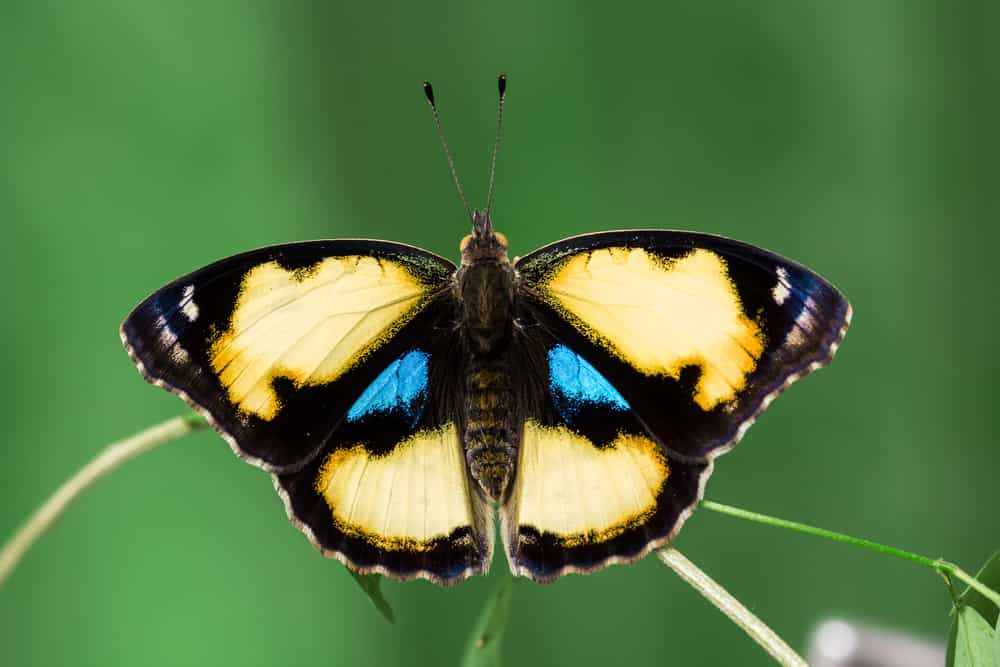
Yellow Pansy butterflies are migratory species native to the Palaeotropics. They inhabit grasslands, farmlands, and semi-deserts.
©CHAINFOTO24/Shutterstock.com
The yellow pansy (Jumonia hierta) belongs to the Nymphalid family, the largest butterfly family with over 6,000 species. They are native to the Palaeotropics and considered migratory. Their flight is fast, and they glide close to the ground. And they are well known for their vivid coloring of black, orange, yellow, and indigo, making them beautiful black and yellow butterflies.
Location/Habitat: As a Palaeotropic species, the yellow pansy is native to Africa and Asia. You will find them in drier areas like grasslands, farmlands, forest edges, and semi-deserts.
Description: Each wing features orange and yellow coloring edged in black or brown with white spots. Both males and females feature brilliant blue spots.
7. Cairns Birdwing
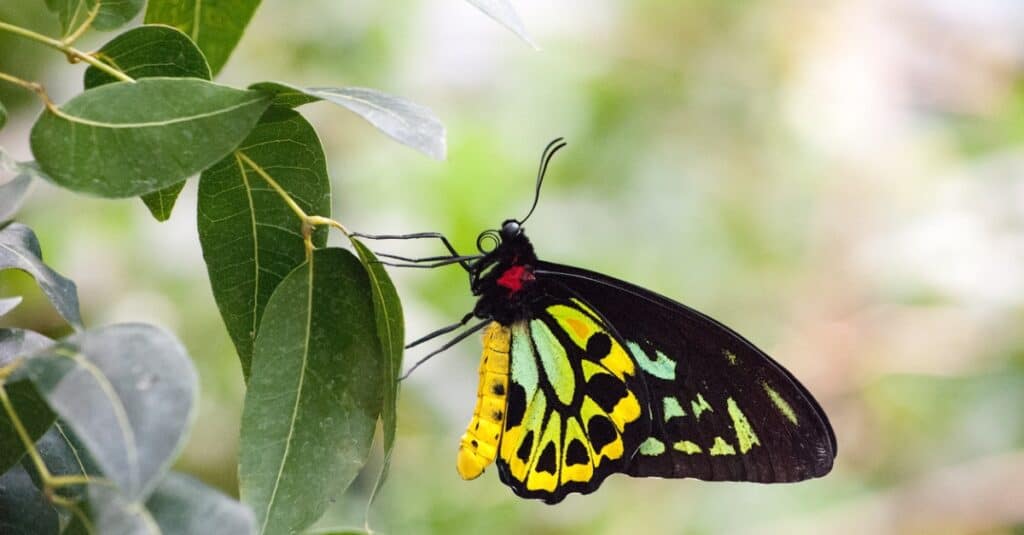
One of the largest butterflies in the world, the birdwing butterfly can be poisonous. They live in the wet tropics region in Queensland, Australia.
©iStock.com/Cathie Moog
The Cairns birdwing (Ornithoptera euphorion) is the largest butterfly in Australia. They are abundant throughout their range, where they often sit on Lantana and Hibiscus flowers in suburban gardens. They are famous for their rare genetic mutation, where females are pale, and males are golden.
Location/Habitat: This birdwing is endemic to Queensland, Australia, where it inhabits rainforests in the wet tropics region.
Description: Females can reach almost six inches and feature black wings with white and yellow patches. Males have black wings with emerald green and yellow patches.
8. Chocolate Albatross
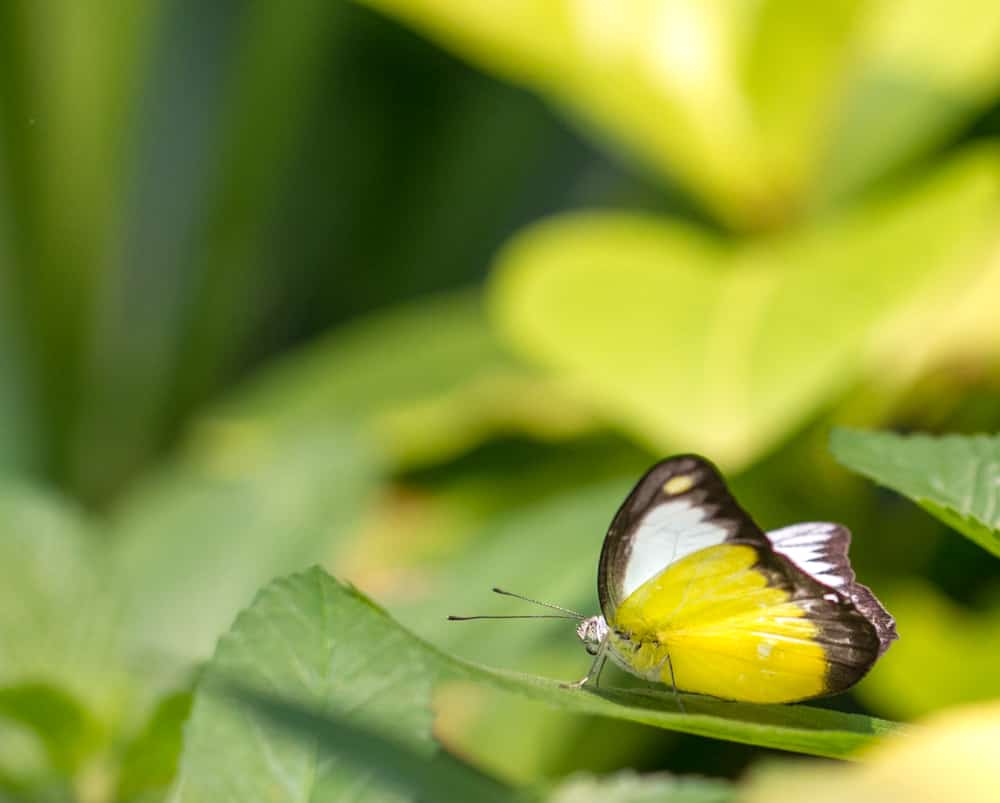
Chocolate
Albatross
butterflies are a tropical species found in Southeast Asia. They prefer moist highlands near streams and jungle clearings.
©Sinseeho/Shutterstock.com
The chocolate albatross (Appias lyncida) is a tropical species from the Pieridae family, which encompasses 1,100 species from Asia and Africa. It is common and abundant in some areas while scarce and local in other regions. This species shows seasonal dimorphism, with a wet season and dry season form.
Location/Habitat: The chocolate albatross is native to Southeast Asia and has a wide range. In fact, it lives in India, China, Myanmar, Sri Lanka, Malaysia, Thailand, Laos, Philippines, Indochina, Taiwan, and Hainan. They are forest butterflies, preferring moist highlands near stream banks. They also enjoy jungle clearings.
Description: Males are lemon yellow with black margins, and females are white and dark brown.
9. Mourning Cloak

The mourning cloak is a large species from North America and Eurasia. They are fond of hardwood forests in cold mountainous regions.
©Marek Mierzejewski/Shutterstock.com
Mourning cloaks (Nymphalis antiopa), also known as the “Camberwell beauty” in Britain, are the state insects of Montana and have one of the longest lifespans in the butterfly world (11 to 12 months). They are a large species native to North America and Eurasia. As a result of their size, they are commonly sighted throughout their range.
Location/Habitat: You will find the mourning cloak in almost all parts of North America, Northern Europe, and Asia. And they live in many different habitats. However, they are especially fond of hardwood forests in cold mountainous regions.
Description: Their upper sides are blackish-brown and edged in light yellow with bright blue spots. Additionally, the undersides are dark brown and edged in light brown.
10. Yellow Coster
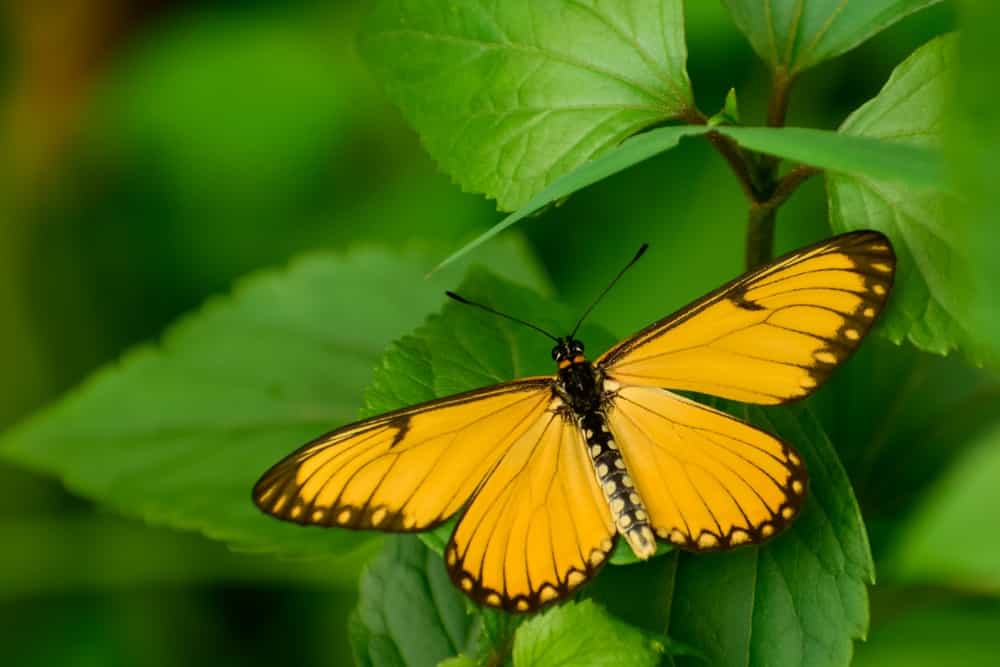
The yellow coster features leathery wings and a tough exoskeleton, which protects it from predators.
©Jitender kumarj/Shutterstock.com
Yellow coster butterflies (Acraea issoria) are a small species of black and yellow butterflies from the Nymphalidae family. In addition to their tiny size, they are unique for their leathery wings and tough exoskeleton, which protect them from predators like lizards. And this butterfly also exudes a noxious fluid from the glands in its legs.
Location/Habitat: The yellow coster lives in the Western Himalayas in Asia.
Description: This species is yellowish-orange with thin black lines and edges.
Bonus: Which Animals Prey on Butterflies?
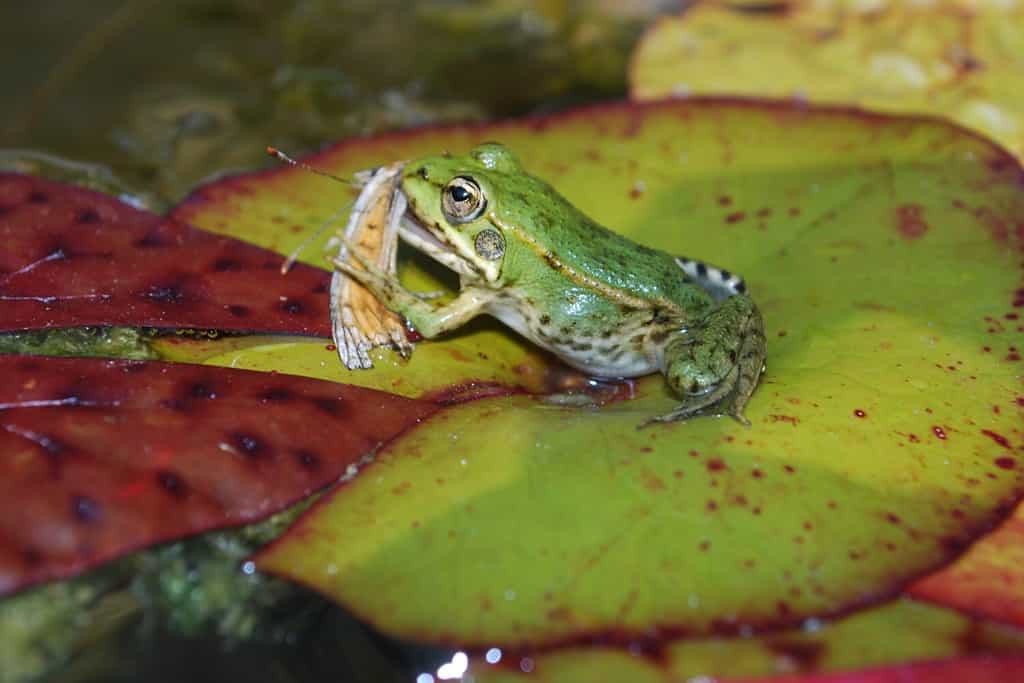
Frogs and other amphibians prey on butterflies.
©LouiesWorld1/Shutterstock.com
Butterflies live a dangerous life with many hungry creatures ready to eat them at every stage of their development. From the vulnerable eggs, and slow-moving caterpillars to winged adults – butterflies wear their bright colors at their peril by attracting the attention of numerous predators. Birds, reptiles, amphibians, small mammals, and even humans eat butterflies at various stages of their metamorphosis.
Like other insects, butterflies have a few defense mechanisms such as the ability to fly at high speeds to escape predators. Some, like the red admiral caterpillar, eat stinging nettle for protection while others have eye spots on their wings to confuse their enemies. Brightly colored butterflies are often identified by predators as being poisonous – while duller insects have camouflage that blends with leaves or tree barks.
Summary of 10 Types of Black and Yellow Butterfly
| # | Butterfly | Native Habitat |
|---|---|---|
| 1 | Giant Swallowtail | Eastern United States and some parts of Canada, Mexico, Jamaica, and Cuba |
| 2 | Yucca Giant Skipper | Southern United States and Northern Mexico |
| 3 | Southern Festoon | Central and Southern Europe |
| 4 | Northern Chequered Skipper | Northern Europe to Northeastern Asia |
| 5 | Spanish Festoon | Southern France, Spain, Portugal, and North Africa |
| 6 | Yellow Pansy | Africa and Asia |
| 7 | Cairns Birdwing | Queensland, Australia |
| 8 | Chocolate Albatross | India, China, Myanmar, Sri Lanka, Malaysia, Thailand, Laos, Philippines, Indochina, Taiwan, and Hainan |
| 9 | Mourning Cloak | North America, Northern Europe, and Asia |
| 10 | Yellow Coster | Western Himalayas |
The photo featured at the top of this post is © iStock.com/rybalov77
Thank you for reading! Have some feedback for us? Contact the AZ Animals editorial team.




